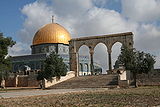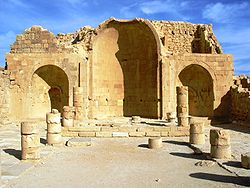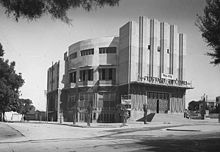
Architecture of Israel
Encyclopedia
The architecture of Israel is composed of many different styles of building brought in by those who have occupied the country over the ages, sometimes modified to suit the local climate and landscape. Fortified Crusader
castles, Islamic madrassas, Byzantine
churches, Templer
houses, Bauhaus
-style modernist buildings, Arab
arches and minarets, Russian Orthodox onion domes, and soaring glass-sided skyscrapers - all are part of the architecture of Israel.

 The Arabs built small stone houses on the hillsides with flat or dome roofs. The Crusaders built fortresses on strategic hilltops. The Christians built churches to mark sites where Jesus walked. The Templers built homes with tiled roofs like those in the German countryside. The British Mandatory authorities passed a law requiring all construction in Jerusalem to be of Jerusalem stone
The Arabs built small stone houses on the hillsides with flat or dome roofs. The Crusaders built fortresses on strategic hilltops. The Christians built churches to mark sites where Jesus walked. The Templers built homes with tiled roofs like those in the German countryside. The British Mandatory authorities passed a law requiring all construction in Jerusalem to be of Jerusalem stone
and introduced the idea of garden suburbs. In the early years of statehood, Israel built rows of concrete tenements to accommodate the masses of new immigrants to replace the huts, tents and packing crates of the maabarot
.
Tel Aviv's White City of Tel Aviv has been declared a UNESCO
World Heritage Site. As property values have risen, skyscrapers are going up around the country. The Moshe Aviv Tower in Ramat Gan is the tallest building in Israel to date.
 Dov Karmi
Dov Karmi
, Zeev Rechter and Arieh Sharon
were among the leading architects of the early 1950s. Rudolf (Reuven) Trostler played an important role in designing the country's early industrial buildings. Dora Gad
designed the interiors of the Knesset
, the Israel Museum
, the country's first large hotels, the Jewish National and University Library
, El Al
planes and Zim
passenger ships. Amnon Niv
designed Moshe Aviv Tower, Israel's tallest building.
consisted of a single room without partitions, divided into levels in accordance with various functions carried out in the house:
In the second half of the 19th century, a residential story characterized by a cross-vault was added above the traditional house, creating a created between the floor with the livestock in the bottom room and the residential story. A separate entrance was installed in each story.
 The architecture of Tel Aviv's movie theaters can be seen as a reflection of Israeli architectural history: The first cinema, the Eden, opened in 1914, was an example of the eclectic
The architecture of Tel Aviv's movie theaters can be seen as a reflection of Israeli architectural history: The first cinema, the Eden, opened in 1914, was an example of the eclectic
style that was in vogue at the time, combining European and Arab traditions. The Mugrabi cinema, designed in 1930, was built in art deco
style. In the late 1930s, the Esther, Chen and Allenby theaters were prime examples of the Bauhaus
style. In the 1950s and 1960s, brutalist style architecture was exemplified by the Tamar cinema built inside the historic Solel Boneh
building on Allenby Street
.
Crusades
The Crusades were a series of religious wars, blessed by the Pope and the Catholic Church with the main goal of restoring Christian access to the holy places in and near Jerusalem...
castles, Islamic madrassas, Byzantine
Byzantine
Byzantine usually refers to the Roman Empire during the Middle Ages.Byzantine may also refer to:* A citizen of the Byzantine Empire, or native Greek during the Middle Ages...
churches, Templer
Templers (religious believers)
Templers are members of the Temple Society , a German Protestant sect with roots in the Pietist movement of the Lutheran Church. The Templers were expelled from the church in 1858 because of their millennial beliefs. Their aim was to realize the apocalyptic visions of the prophets of Israel in the...
houses, Bauhaus
Bauhaus
', commonly known simply as Bauhaus, was a school in Germany that combined crafts and the fine arts, and was famous for the approach to design that it publicized and taught. It operated from 1919 to 1933. At that time the German term stood for "School of Building".The Bauhaus school was founded by...
-style modernist buildings, Arab
Arab
Arab people, also known as Arabs , are a panethnicity primarily living in the Arab world, which is located in Western Asia and North Africa. They are identified as such on one or more of genealogical, linguistic, or cultural grounds, with tribal affiliations, and intra-tribal relationships playing...
arches and minarets, Russian Orthodox onion domes, and soaring glass-sided skyscrapers - all are part of the architecture of Israel.

Architectural styles

Jerusalem stone
Jerusalem stone is a name applied to various types of pale limestone, dolomite and dolomitic limestone, common in and around Jerusalem that have been used in building since ancient times...
and introduced the idea of garden suburbs. In the early years of statehood, Israel built rows of concrete tenements to accommodate the masses of new immigrants to replace the huts, tents and packing crates of the maabarot
Maabarot
Ma'abarot is a kibbutz in Israel. Founded in 1932, today it has a population of approximately 850 people, and is under the jurisdiction of Hefer Valley Regional Council.-Beginnings :...
.
Tel Aviv's White City of Tel Aviv has been declared a UNESCO
UNESCO
The United Nations Educational, Scientific and Cultural Organization is a specialized agency of the United Nations...
World Heritage Site. As property values have risen, skyscrapers are going up around the country. The Moshe Aviv Tower in Ramat Gan is the tallest building in Israel to date.
Leading architects

Dov Karmi
- Biography :Karmi was born in 1905 in Odessa, Ukraine, then part of the Russian Empire. In 1921 he emigrated to British-ruled Palestine ....
, Zeev Rechter and Arieh Sharon
Arieh Sharon
Arieh Sharon was an Israeli architect and winner of the Israel Prize for Architecture in 1962—the first in this discipline. Sharon was a critical contributor to the early architecture in Israel and the leader of the first master plan of the young state, reporting to then Prime Minister, David...
were among the leading architects of the early 1950s. Rudolf (Reuven) Trostler played an important role in designing the country's early industrial buildings. Dora Gad
Dora Gad
Dora Gad was an Israeli interior designer, whose work had significant influence on the development of modern Israeli architecture.- Early life :...
designed the interiors of the Knesset
Knesset
The Knesset is the unicameral legislature of Israel, located in Givat Ram, Jerusalem.-Role in Israeli Government :The legislative branch of the Israeli government, the Knesset passes all laws, elects the President and Prime Minister , approves the cabinet, and supervises the work of the government...
, the Israel Museum
Israel Museum
The Israel Museum, Jerusalem was founded in 1965 as Israel's national museum. It is situated on a hill in the Givat Ram neighborhood of Jerusalem, near the Bible Lands Museum, the Knesset, the Israeli Supreme Court, and the Hebrew University of Jerusalem....
, the country's first large hotels, the Jewish National and University Library
Jewish National and University Library
The National Library of Israel , is the national library of Israel...
, El Al
El Al
El Al Israel Airlines Ltd , trading as El Al , is the flag carrier of Israel. It operates scheduled domestic and international services and cargo flights to Europe, North America, Africa and the Far East from its main base in Ben Gurion International Airport...
planes and Zim
Zim
Zim or ZIM may refer to:* Zero Index Metamaterial* Zimbabwe* Nzime, a people of Cameroon* GAZ-12 ZIM, limousine* Invader Zim, a 2001 animated television series** Zim, the title character from Invader ZIM...
passenger ships. Amnon Niv
Amnon Niv
Amnon Niv, , an Israeli architect and urban designer. Niv was the chief architect for the Nuclear Research center in the Negev and the City Engineer of Jerusalem. Together with Amnon Schwartz, he designed the tallest building in Israel.- Biography :Amnon Niv was born in Haifa...
designed Moshe Aviv Tower, Israel's tallest building.
Traditional rural house
Until the end of the 19th century, the traditional rural house in the villages of IsraelIsrael
The State of Israel is a parliamentary republic located in the Middle East, along the eastern shore of the Mediterranean Sea...
consisted of a single room without partitions, divided into levels in accordance with various functions carried out in the house:
- Rawiyeh – a bottom level at the elevation of the courtyard considered the “dirty” part of the house, used for storage and sheltering livestock.
- Mastabeh – A higher residential level used for sleeping, eating, hospitality and storage.
- Sida (gallery) – Another living area above the mastaba, used primarily for sleeping.
In the second half of the 19th century, a residential story characterized by a cross-vault was added above the traditional house, creating a created between the floor with the livestock in the bottom room and the residential story. A separate entrance was installed in each story.
Fortified house
These houses were built outside the village core and had two stories: a raised ground floor with tiny windows used for raising livestock and storage, and a separate residential floor with large windows and balconies. In the courtyard was a small structure used for storage. Sometimes a tabun baking oven would be located inside it.Farmhouses
The first modern building technology was evident in the farmhouses. Iron beams were used and the roofs were made of concrete and roof tiles. These structures had balconies with a view and wide doorways.Modern housing (British Mandate)
Modern housing built during the British Mandate was urban in character, with flat roofs, rectangular doorways and painted floor tiles.After Israeli independence
From 1948, architecture in Israel was dominated by the need to house masses of new immigrants. The Brutalist concrete style suited Israel's harsh climate and paucity of natural building materials.Movie theaters as architectural milestones

Eclecticism in art
Eclecticism is a kind of mixed style in the fine arts: "the borrowing of a variety of styles from different sources and combining them" . Significantly, Eclecticism hardly ever constituted a specific style in art: it is characterized by the fact that it was not a particular style...
style that was in vogue at the time, combining European and Arab traditions. The Mugrabi cinema, designed in 1930, was built in art deco
Art Deco
Art deco , or deco, is an eclectic artistic and design style that began in Paris in the 1920s and flourished internationally throughout the 1930s, into the World War II era. The style influenced all areas of design, including architecture and interior design, industrial design, fashion and...
style. In the late 1930s, the Esther, Chen and Allenby theaters were prime examples of the Bauhaus
Bauhaus
', commonly known simply as Bauhaus, was a school in Germany that combined crafts and the fine arts, and was famous for the approach to design that it publicized and taught. It operated from 1919 to 1933. At that time the German term stood for "School of Building".The Bauhaus school was founded by...
style. In the 1950s and 1960s, brutalist style architecture was exemplified by the Tamar cinema built inside the historic Solel Boneh
Solel Boneh
Solel Boneh is the oldest, and one of the largest, construction and civil engineering companies in Israel.-History:Solel Boneh was founded in 1921 during the first conference of the General Histadrut, under the name of Batz , an acronym of Binyan veAvodot Tziburiot . Its first project was to pave...
building on Allenby Street
Allenby Street
Allenby Street is a major street in Tel Aviv, Israel. It was named in honor of Field Marshal Viscount Allenby.Allenby Street stretches from the Mediterranean sea in the northwest to HaAliya Street in the southeast. It was first paved with concrete in 1914. During the day, it is a commercial street...
.
External links
- A little modesty goes a long way David KroyankerDavid KroyankerDavid Kroyanker is an Israeli architect and architectural historian. In 2010, he was named a Yakir Yerushalayim for his research and documentation of the architectural heritage of Jerusalem. Kroyanker has written dozens of books about the city's architecture and urban planning.-Biography:David...
http://www.haaretz.com/hasen/spages/990951.html - Fifty years of Israeli architecture David Kroyanker http://www.mfa.gov.il/MFA/MFA+Publications/Photo+exhibits/Fifty+Years+of+Israeli+Architecture+as+Reflected+i.htm?DisplayMode=print
- Jerusalem: Architecture in the late Ottoman Period Lili Eylon
- http://www.jewishvirtuallibrary.org/jsource/Archaeology/jerott.html
- Historical Architecture and Design in Israel

